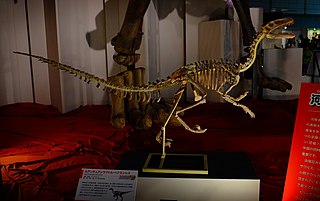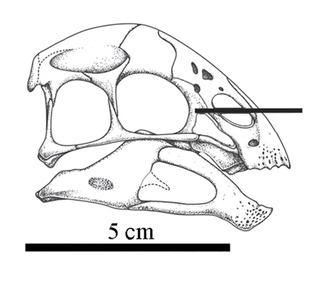
Anserimimus is a genus of ornithomimid theropod dinosaur, from the Late Cretaceous Period of what is now Mongolia. It was a lanky, fast-running animal, possibly an omnivore. From what fossils are known, it probably closely resembled other ornithomimids, except for its more powerful forelimbs.

The Ornithomimosauria, ornithomimosaurs or ostrich dinosaurs are theropod dinosaurs which bore a superficial resemblance to the modern-day ostrich. They were fast, omnivorous or herbivorous dinosaurs from the Cretaceous Period of Laurasia, as well as Africa and possibly Australia. The group first appeared in the Early Cretaceous and persisted until the Late Cretaceous. Primitive members of the group include Nqwebasaurus, Pelecanimimus, Shenzhousaurus, Hexing and Deinocheirus, the arms of which reached 2.4 m (8 feet) in length. More advanced species, members of the family Ornithomimidae, include Gallimimus, Struthiomimus, and Ornithomimus. Some paleontologists, like Paul Sereno, consider the enigmatic alvarezsaurids to be close relatives of the ornithomimosaurs and place them together in the superfamily Ornithomimoidea.

Struthiomimus is a genus of ornithomimid dinosaurs from the late Cretaceous of North America. Ornithomimids were long-legged, bipedal, ostrich-like dinosaurs with toothless beaks. The type species, Struthiomimus altus, is one of the more common small dinosaurs found in Dinosaur Provincial Park; its abundance suggests that these animals were herbivores or omnivores rather than pure carnivores.

Sinornithomimus is a genus of ornithomimid theropod dinosaur found in 1997, in the early Late Cretaceous strata of the Ulansuhai Formation located at Alshanzuo Banner, Inner Mongolia Autonomous Region, Northern China.

Ornithomimidae is a group of theropod dinosaurs which bore a superficial resemblance to modern ostriches. They were fast, omnivorous or herbivorous dinosaurs from the Cretaceous Period of Laurasia, though they have also been reported from the Wonthaggi Formation of Australia. The group first appeared in the Early Cretaceous.

Zhongyuansaurus is an extinct genus of ankylosaurid ankylosaurian dinosaur from the Lower Cretaceous of Ruyang, Henan, China. It is known from remains including skull, arm, pelvic, and tail bones. It is distinguished by characteristics such as a flat roof to the skull, a straight ischium, and the location of muscle attachments on the upper arm. The type species, Z. luoyangensis, was described by Xu and colleagues in 2007. Zhongyuansaurus was described by Xu et al. as the first Chinese nodosaurid based primarily upon the absence of a tail club and its elongate skull, but was reevaluated in 2008 by Kenneth Carpenter and colleagues as a shamosaurine ankylosaurid, a type of ankylosaurid lacking a tail club. A new cladistic analysis performed by Thompson et al., 2011 suggests that Zhongyuansaurus is the basalmost known ankylosaurine and thus it is the first species of this clade known to lack a tail club. In 2014, Victoria Megan Arbour concluded that Zhongyuansaurus was a probable junior synonym of Gobisaurus.

Luanchuanraptor is a genus of dromaeosaurid theropod dinosaurs from the Late Cretaceous of China. The genus is based on a partial skeleton from the Qiupa Formation in Luanchuan, Henan. They were medium-sized dromaeosaurids, the first Asian dromaeosaurid taxa described from outside the Gobi Desert or northeastern China.

Ruyangosaurus is a genus of titanosauriform sauropod dinosaur recovered from the Early Cretaceous Haoling Formation of China. The type species is R. giganteus, described in 2009 by Lü Junchang et al.
The Xiaguan Formation is a Turonian to Campanian geologic formation. Dinosaur remains are among the fossils that have been recovered from the formation.
The Haoling Formation is a Mesozoic geologic formation in the Ruyang Basin of Henan, Province, central China. Dinosaur remains are among the fossils that have been recovered from the formation.

The Gaogou Formation is a Late Cretaceous (Cenomanian-Turonian) geologic formation in China. Fossil dinosaur eggs, the caenagnathid Beibeilong, and the titanosaur Baotianmansaurus have been reported from the formation.
Luoyanggia is a genus of oviraptorid dinosaur known from the Early Cretaceous Haoling Formation of the Ruyang Basin in Henan Province, central China. The type species is L. liudianensis. Holtz estimated it at 1.5 meters and around 2.27-9.1 kg. Molina-Pérez and Larramendi gave a similar size of 1.2 meters and 8.5 kg.

Xianshanosaurus is a genus of titanosaur sauropod dinosaur from the Early Cretaceous (Aptian-Albian) of the Ruyang Basin in Henan Province, China. It was described in 2009 by a team of Chinese paleontologists. The type species is X. shijiagouensis.

The Nanxiong Formation is a Late Cretaceous geologic formation in Guangdong Province. Dinosaur remains are among the fossils that have been recovered from the formation. It consists of red sandstone and clay sediments, with fauna which is more similar to that of the Nemegt Formation in the recent years. It has been dated about 66.7 ± 0.3 million years ago.

Qiupalong is a genus of extinct ornithomimid theropods from the Late Cretaceous of what is now China and Canada.

Yulong is an extinct genus of derived oviraptorid theropod dinosaur known from the Late Cretaceous Qiupa Formation of Henan Province, central China. It contains a single species, Yulong mini. It is known from many juvenile specimens that represent some of the smallest known oviraptorids.
Yunmenglong is an extinct genus of somphospondylan sauropod known from the late Early Cretaceous of Henan Province, central China. Its remains were discovered in the Haoling Formation of the Ruyang Basin. The type species is Yunmenglong ruyangensis, described in 2013 by Junchang Lü et al. on the basis of an incomplete postcranial skeleton. Yunmenglong shares some characters with Euhelopus, Qiaowanlong and Erketu, and a phylogenetic analysis places it as a sister taxon of Qiaowanlong, both grouped with Erketu in a position more derived than Euhelopus but basal to Titanosauria. Yunmenglong represents the first long-necked sauropod dinosaur recorded from central China to date.

This timeline of oviraptorosaur research is a chronological listing of events in the history of paleontology focused on the oviraptorosaurs, a group of beaked, bird-like theropod dinosaurs. The early history of oviraptorosaur paleontology is characterized by taxonomic confusion due to the unusual characteristics of these dinosaurs. When initially described in 1924 Oviraptor itself was thought to be a member of the Ornithomimidae, popularly known as the "ostrich" dinosaurs, because both taxa share toothless beaks. Early caenagnathid oviraptorosaur discoveries like Caenagnathus itself were also incorrectly classified at the time, having been misidentified as birds.
Qiupanykus is a genus of alvarezsaurid coelurosaur theropod from the Late Cretaceous Qiupa Formation of southern China.

Yubaatar is a genus of multituberculate, an extinct order of rodent-like mammals, which lived in what is now China during the Late Cretaceous. The first specimen was discovered in the Qiupa Formation of Luanchuan County, in the Henan Province. The specimen consists of a partial skeleton with a nearly complete skull, and was made the holotype of the new genus and species Yubaartar zhongyuanensis by the Chinese palaeontologist Li Xu and colleagues in 2015. The generic name consists of the word Yu, which is the pinyin spelling of the Chinese character for the Henan Province, and the Mongolian word baatar, which means "hero", a word commonly used as suffix in the names of Asian multituberculates. The specific name comes from Zhongyuan, an ancient name for the geographic area of the province.





















